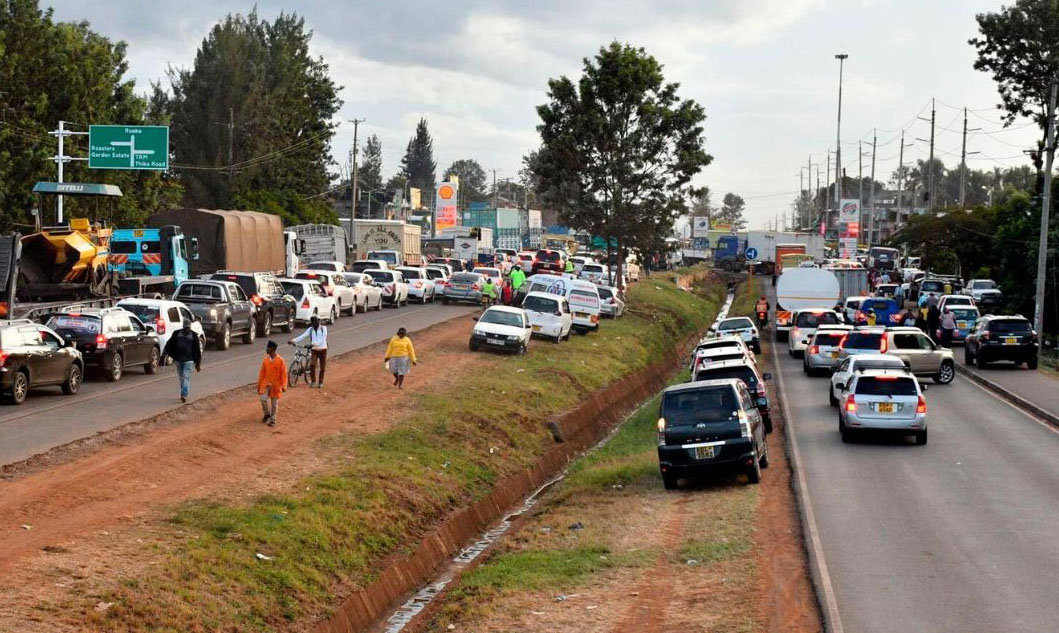
 Motorists in traffic along the 20.2km Nairobi Northern Bypass road /File
Motorists in traffic along the 20.2km Nairobi Northern Bypass road /File
Motorists using Nairobi’s Northern Bypass may soon find relief from the frequent traffic gridlocks that plague the route, following the Cabinet’s approval of a long-awaited upgrade and expansion.
The road, which currently operates as the city’s only single-carriageway bypass, will be expanded into a dual carriageway — a move expected to ease congestion, improve safety and enhance regional connectivity.
In a Cabinet meeting chaired by President William Ruto on Tuesday, the government formally endorsed the expansion of the 20.2km stretch running from Ruaka to Ruiru.
The road links the Western and Eastern bypasses, making it a critical transport artery for Nairobi and its surrounding counties.
The proposed upgrade includes the construction of a dual carriageway with eight modern interchanges, along with overpasses and underpasses aimed at ensuring seamless traffic movement.
To support inclusive and sustainable transport, the project will also incorporate non-motorised transport infrastructure — including pedestrian walkways and dedicated cycle lanes — alongside enhanced drainage and connections to feeder roads.
Currently, the bypass is notorious for traffic congestion, especially during rush hours, which has negatively impacted commuters, businesses and the environment.
According to the Cabinet, the traffic jams have led to long travel delays, higher fuel consumption, increased transport costs, reduced worker productivity and elevated levels of air pollution.
“The upgrade is expected to improve traffic flow, enhance road safety and boost access to economic hubs, industrial zones, and essential services in both Nairobi and Kiambu counties,” the Cabinet said in an official statement.
The project aligns with the government’s broader infrastructure development strategy to ease urban mobility pressures in Nairobi and improve logistical links to neighbouring counties such as Kiambu, Murang’a and Machakos.
The improved bypass will also facilitate faster access to key economic installations, including industrial parks and logistical centers, enhancing the capital’s competitiveness.
In a related development, the Cabinet also approved the implementation of the Nairobi railway City Central Station and public realm project, a transformative urban renewal initiative designed to modernise the capital’s primary rail hub and reduce pressure on the central business district.
The redevelopment will turn the current Nairobi Central Station into a high-capacity, multi-modal transit interchange capable of accommodating growing passenger volumes.
Cabinet projections indicate that daily passenger traffic at the upgraded station could rise to 400,000 by 2030 and up to 600,000 by 2045.
To meet this demand, the new facility will feature nine platforms, advanced signalling systems and pedestrian access bridges capable of safely moving up to 30,000 people per hour.
The surrounding public realm will also receive significant upgrades. The plan includes opening up underutilised urban land for commercial and public use, encouraging foot traffic, and driving economic revitalisation in the city centre.
Funding has already been secured for several components of the project, including the development of Bus Rapid Transit Line 3, expanded commuter rail routes, and an integrated Standard Gauge Railway connection to Jomo Kenyatta International Airport.
These enhancements aim to establish Nairobi as a fully integrated and efficient urban transport hub.
The Cabinet emphasised that both projects — the Northern Bypass upgrade and the Railway City initiative — will contribute to job creation, sustainable urban development and a reduction in Nairobi’s notorious traffic congestion.
Together, they form part of a long-term plan to reshape the capital’s infrastructure landscape and support its role as East Africa’s commercial and logistics gateway.
Instant Analysis
The dual carriageway expansion and the Railway City project represent a significant leap toward easing Nairobi’s transport woes.
If executed efficiently, they could catalyse economic growth, reduce urban congestion, and make the city more livable and competitive.








![Mobile [SIM] Subscriptions in Kenya](/_next/image?url=https%3A%2F%2Fcdn.radioafrica.digital%2Fimage%2F2025%2F07%2F4adb0c0f-625e-418c-904f-77f7a4e5bd35.jpeg&w=3840&q=100)


